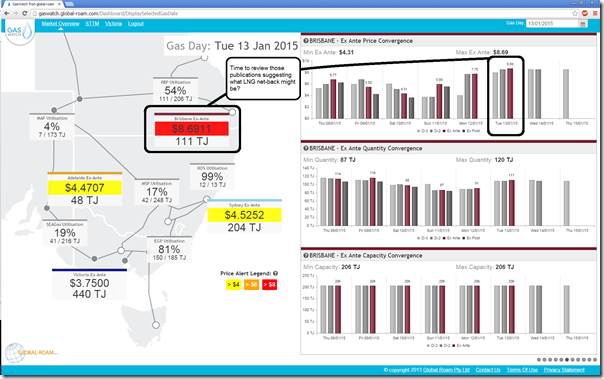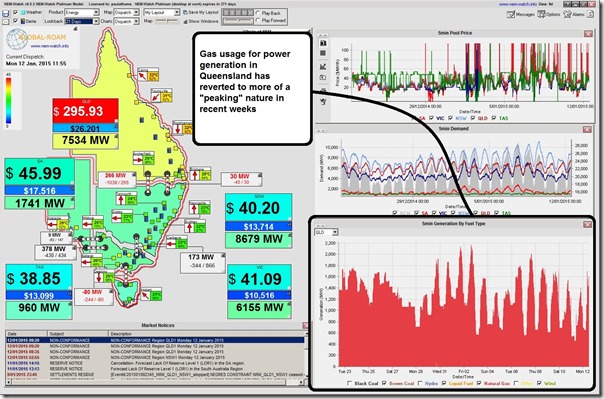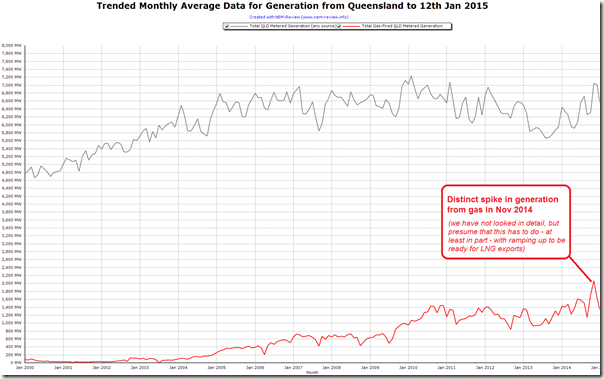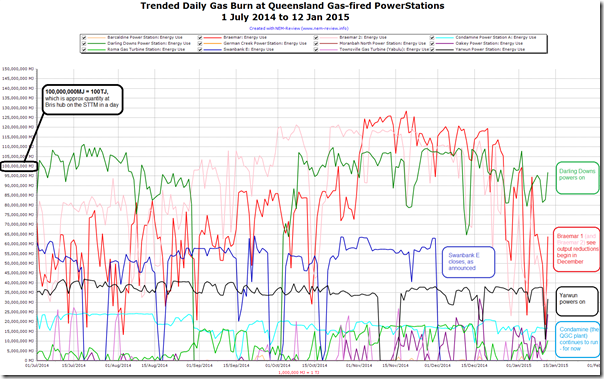Yesterday evening I received an advert for the latest joint UQ + Grattan Institute event in Brisbane on Thursday 5th February provocatively titled “Gas: too good to burn?”.
Upon reaching the office this morning and reviewing our series of dashboards, I was confronted with this stark reminder from GasWatch:
No, that’s not a misprint. At a price of $8.69/GJ today at the Brisbane hub, it seems that there surely are people falling over themselves to gain access to short-term gas.
Eight-buck-gas would be newsworthy at any particular time of year – at least for the east coast (with the west having been stung a long time ago), and particularly for Queensland given the low gas prices seen at the Brisbane hub through much of 2014 (such as here in September). In the prolonged holiday season, with a state election only a couple weeks away (one with some focus on gas and electricity), and with the first LNG deliveries leaving Gladstone, it makes does make for interesting reading – hence articles like this in the FinReview.
In NEM-Watch yesterday, we saw how gas production volumes in Queensland had reduced through December:
It’s important to note that gas has not entirely disappeared (far from it – for now, at least?). Hence the title of the event might be tweaked to be “Gas – too good to burn for next-to-nothing in the middle of the night” (though that is more of a mouthful).
Powering up NEM-Review to look further back in history, we see the following trend of how generation from gas in Queensland grew from next-to-nothing in the early years to be given a kick-start in 2005 with the start of the Queensland Gas Scheme to the current point in time:
At a more microscopic level, looking just from 1st July 2014 through to now and using NEM-Review to calculate daily gas burn at Queensland power stations, we see how some gas stations have had their production levels curtailed, whilst others are continuing to power on (at least for now).
The other point that can be gleaned from the relative volumes of gas burn (keeping in mind that 1,000,000 MJ = 1TJ) is that the volumes of reduction in gas burn each day account for the same order of magnitude as the total quantities delivered at the Brisbane hub of the STTM. Bodes for interesting times at Queensland’s gas/electricity intersection through 2015.
I will be interested to see what comes out of the discussions at State Library on 5th February.
Whilst on the topic of conversations about gas, I can’t help but notice Keith Orchison’s promotions for the upcoming “Australian Domestic Gas Outlook 2015” conference on 23/24/25/26 March. Might also be useful for those who are interested.
[Note that we’re not associated with either event in any way – just mention them as a service to our readers]






Hey Paul,
So what does this mean for gas powered generators? My understanding is gas can change output much much faster than goal which means some companies must be making a bucket load.
Do you think with more renewables gas will play a much bigger role in the future to supply peak demand when the renewables wane? I’ve been quite skeptical of the many green oriented articles stating that gas electricity will play a tiny role in the future of Australia’s energy market.